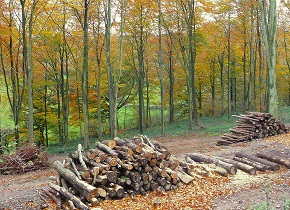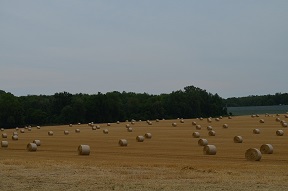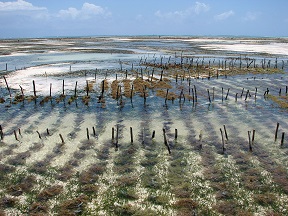Once upon a time, energy from biomass like wood, manure, whale oil and other sources was the primary supplier of heat, light and food processing. If we should like to contain climate change effectively, would we have to return to those times?
This article was first published (in Dutch) on the site of wattisduurzaam.nl.

Energy from biomass has clear advantages and disadvantages. Just like coal, wind, nuclear and all other energy sources, biomass is controversial. Clear advantages of biomass: it is renewable, and also available if there is no wind. Clear disadvantages: it takes a lot of time and space for biomass to grow; and energy from biomass is in competition with biomass for food, construction materials and natural areas.
Not just any controversial energy source
As an informed layperson, one could try to balance these advantages and disadvantages. But there is more to it. A clear difference between biomass and all other controversial energy sources is the large number of additional vague complaints. Depending on one’s reasoning, one could hold that energy from biomass is:
– either CO2-positive or even worse for the climate than coal;
– either a benefit to biodiversity or detrimental to flora and fauna;
– either air polluting or an effective measure against forest fires.
Biomass will appear in many forms: trimmings, manure, sunflower oil, fireplace wood, green waste, pig fat, seaweed. And there are many pathways for collecting this biomass: waste streams, cultivation, imports, wood clearing. And there are many ways to process biomass: open hearth, combustion engine, coal-fired power station, gasification etc. Therefore, there are many opportunities for people to arrive at their preferred outcomes through assumptions of their own. As a result even specialists usually misunderstand each other. And consequently, many protests, articles, debates are a travesty, and that even holds for reflections that intend to be neutral. Everybody’s opinion is true. Nobody learns.

Renewability does not equal CO2 neutrality
If we fell a tree today, there may grow a tree the same size in 30 to 50 years’ time. If we cut a chunk of coal in a mine today, it will not have grown back within 50 years. Both the wood and the coal produce CO2 upon incineration. If we don’t fell the tree but do burn the coal, the CO2 produced can only be absorbed by a new tree in another location. If we continue to burn coal, we will run out of locations for trees. On the moment of burning, the climate effect for both energy sources is equally detrimental. The difference is that on burning biomass, there is a chance that the CO2 produced will be balanced by CO2 absorbed. We need to stress that this is a chance. We can easily destroy biomass’s sustainability by burning it faster than it grows. In such a scenario, burning biomass is at least as rotten as burning coal. So, biomass is not sustainable all by itself. Policy, effort and monitoring are required in order to control the balance between growth and use of biomass.
CO2 neutrality does not equal sustainability
All in all, biomass use that balances growth is really CO2 neutral. Unfortunately, in the 70s and 80s of the past century, few trees have been planted with the intention to burn these in a CO2 neutral way in 2019. Many trees have been planted with the intention to produce paper, book shelves or matches from them. Just branches with certain characteristics are fit to be processed into book shelves and the demand for paper and matches may be lower than projected in 1976. Therefore on balance, a certain amount of wood is available for CO2 neutral energy production. But it doesn’t amount to much.
Fortunately, wood is just one of many forms of biomass. Much biomass has much shorter growth cycles, like maize, sugar cane, palm oil and rapeseed. Energy from biomass produced from these sources will grow again within a year. The disadvantage of these very productive crops is that they only grow on land on which we could produce food as well.
The debate on conflicting food and bioenergy productions has been raging for longer than the present controversy over wood incineration. Back then, the debate was decided in favour of food production. Biomass is sustainable only insofar is has grown on land unfit for food production: woods, roadside grass, algae, seaweed. Or if it represents inedible side streams of food production: banana peels, manure, bread grown mouldy, listeria-contaminated meat etc.

Simple price subsidy will not promote the transition
The increasing global population cannot afford food shortages just because we need energy from biomass. Governments cannot afford subsidies that promote the incineration of biomass at a faster pace than growth. There are clear limits to the sustainable use of biomass.
As for existing subsidy schemes, they fail the test set by this criterion. In view of the inherent shortages, it is of no use to heat swimming pools all year long with biomass, or feed coal-fired power stations continuously with wood pellets. The price difference between energy from biomass and from fossil fuels is primarily in biomass costs, not in incineration technology. Therefore, existing subsidies on biomass primarily cover the difference in fuel costs. Assuming that biomass shortages will continue, that difference in fuel costs is of a structural nature. Therefore a learning curve, as in the cases of wind turbines, solar panels and electric cars, is not likely to occur. If the subsidy should disappear, that would almost certainly end this biomass application right away.
Moreover, in the present (Dutch) subsidy setup, biomass use is in direct competition with other renewable techniques of heat and electricity production. Because coal-fired power stations (that co-fire wood pellets) can sell their electricity at a lower price because of the subsidy, this subsidy tends to lower electricity prices in general. The subsidy is a rebate, calculated from the difference between the price on the market and a guaranteed price set beforehand. Therefore, subsidy on wood pellets will probably push up subsidies on wind and solar parks as well. This is a counterproductive result.
Just subsidize biomass for purposes not met by solar and wind power
In view of shortages, complexity and negative public sentiment, it would seem to be politically attractive to write off biomass completely. Some politicians do. But that is too easy as a solution.
If we would like to challenge climate change head-on, we need to recognise energy from biomass as an almost indispensable ingredient of a package that contains rather few items. For biomass has three crucial qualities that can hardly be matched.
1. Biomass is energy storage
In an energy system based on solar and wind power, energy storage is essential. Biomass is energy storage. By its very nature. The wood pellets that we now feed into the coal-fired power station could be reserved for use in very cold winters, in peak boilers in district heating. At present we use biogas for immediate production of electricity; but we could better store it in salt caverns, for electricity production in windless weather. Subsidize biomass in such a way that it complements solar and wind power.
2. Biomass is a resource
In a thriving economy that cannot use oil and gas, sustainable hydrocarbons are essential. We can produce anything from biomass: packaging, clothing, laptop casing, bulletproof vests and all products now made from fossil resources. We could also construct houses, offices, wind turbines and bridges from biomass. Subsidize biomass in such a way that it will reduce our dependence on fossil resources and on CO2 intensive cement and steel.
3. Biomass is captured CO2
Trees and plants capture CO2 as they grow. Trees and plants that rot away, release CO2. We can make use of this natural carbon cycle for the capture of CO2 from the atmosphere. If we construct a house from wood, the CO2 captured in that wood will remain in the house as long as it exists. If we burn biomass and capture the CO2 released in that process, this will result in a negative release of CO2. Subsidize biomass in such a way that it will actively capture CO2 from the air.
Public opinion is right if it judges present biomass policies to be suboptimal. We need to recognize that, while recognizing at the same time that subsidies granted under the present schemes need to be continued until 2025 (because of legal certainty). But we need to pledge better schemes in the future. By policies that promote energy from biomass as part of a final solution. Let’s not turn sour the existing sentiment on biomass by easy solutions. Let’s show leadership. Let’s use the available amount of sustainably sourced biomass effectively.
Interesting? Then also read:
Bioenergy: fine, if from side streams
Respectful treatment of the complexity of biomass
Whole crop valorisation
